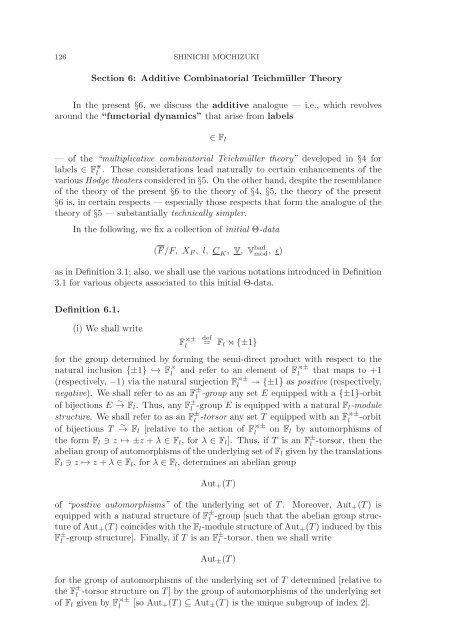Inter-universal Teichmuller Theory I: Construction of Hodge Theaters
Inter-universal Teichmuller Theory I: Construction of Hodge Theaters
Inter-universal Teichmuller Theory I: Construction of Hodge Theaters
Create successful ePaper yourself
Turn your PDF publications into a flip-book with our unique Google optimized e-Paper software.
126 SHINICHI MOCHIZUKI<br />
Section 6: Additive Combinatorial Teichmüller <strong>Theory</strong><br />
In the present §6, we discuss the additive analogue — i.e., which revolves<br />
around the “functorial dynamics” that arise from labels<br />
∈ F l<br />
—<strong>of</strong>the“multiplicative combinatorial Teichmüller theory” developed in §4 for<br />
labels ∈ F l<br />
. These considerations lead naturally to certain enhancements <strong>of</strong> the<br />
various <strong>Hodge</strong> theaters considered in §5. On the other hand, despite the resemblance<br />
<strong>of</strong> the theory <strong>of</strong> the present §6 tothetheory<strong>of</strong>§4, §5, the theory <strong>of</strong> the present<br />
§6 is, in certain respects — especially those respects that form the analogue <strong>of</strong> the<br />
theory <strong>of</strong> §5 — substantially technically simpler.<br />
In the following, we fix a collection <strong>of</strong> initial Θ-data<br />
(F/F, X F , l, C K , V, V bad<br />
mod, ɛ)<br />
as in Definition 3.1; also, we shall use the various notations introduced in Definition<br />
3.1 for various objects associated to this initial Θ-data.<br />
Definition 6.1.<br />
(i) We shall write<br />
F ⋊±<br />
l<br />
def<br />
= F l ⋊ {±1}<br />
for the group determined by forming the semi-direct product with respect to the<br />
natural inclusion {±1} ↩→ F × l<br />
and refer to an element <strong>of</strong> F ⋊±<br />
l<br />
that maps to +1<br />
(respectively, −1) via the natural surjection F ⋊±<br />
l<br />
↠ {±1} as positive (respectively,<br />
negative). We shall refer to as an F ± l<br />
-group any set E equipped with a {±1}-orbit<br />
<strong>of</strong> bijections E → ∼ F l . Thus, any F ± l -group E is equipped with a natural F l-module<br />
structure. We shall refer to as an F ± l<br />
-torsor any set T equipped with an F⋊±<br />
l<br />
-orbit<br />
<strong>of</strong> bijections T → ∼ F l [relative to the action <strong>of</strong> F ⋊±<br />
l<br />
on F l by automorphisms <strong>of</strong><br />
the form F l ∋ z ↦→ ±z + λ ∈ F l ,forλ ∈ F l ]. Thus, if T is an F ± l<br />
-torsor, then the<br />
abelian group <strong>of</strong> automorphisms <strong>of</strong> the underlying set <strong>of</strong> F l given by the translations<br />
F l ∋ z ↦→ z + λ ∈ F l ,forλ ∈ F l , determines an abelian group<br />
Aut + (T )<br />
<strong>of</strong> “positive automorphisms” <strong>of</strong> the underlying set <strong>of</strong> T . Moreover, Aut + (T )is<br />
equipped with a natural structure <strong>of</strong> F ± l<br />
-group [such that the abelian group structure<br />
<strong>of</strong> Aut + (T ) coincides with the F l -module structure <strong>of</strong> Aut + (T ) induced by this<br />
F ± l -group structure]. Finally, if T is an F± l<br />
-torsor, then we shall write<br />
Aut ± (T )<br />
for the group <strong>of</strong> automorphisms <strong>of</strong> the underlying set <strong>of</strong> T determined [relative to<br />
the F ± l<br />
-torsor structure on T ] by the group <strong>of</strong> automorphisms <strong>of</strong> the underlying set<br />
<strong>of</strong> F l given by F ⋊±<br />
l<br />
[so Aut + (T ) ⊆ Aut ± (T ) is the unique subgroup <strong>of</strong> index 2].
















